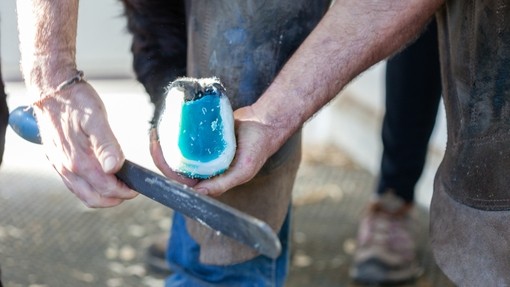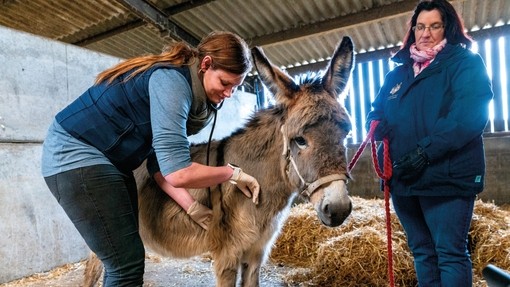Small strongyles (cyathostomins)
Small strongyles are a concern for many equine owners and should be controlled and assessed using a dosing programme including a once yearly larvicidal treatment (e.g. MOX). Faecal worm egg counts (FWEC) are useful throughout the grazing season to assess new infections and to assist with reducing pasture contamination; they do not provide any information on the presence of encysted larvae so should not be relied upon for this purpose.
Donkeys do not appear to show classical signs of larval cyathostominosis; they are more likely to present weight loss, colitis and lowered total proteins on a blood sample.
The decision to treat for small strongyles (other than a once yearly treatment for encysted larvae) should be based upon a FWEC. There is no recognised threshold for treatment, but in the majority of cases a FWEC 300 epg is reasonable. When individual animals are routinely presenting with high FWECs, it is recommended that screening for PPID is undertaken as there appears to be an association between this and high FWECs.
Drug Choices
All classes of drug licensed against the cyathostomin family appear to be safe to use in donkeys when dosed according to weight and using guidelines developed for other equines. However, some drug classes (MOX) are not licensed for use in donkeys but may be prescribed using the ‘Cascade’ system.
Moxidectin should be reserved for targeted use against encysted larvae only. Other drugs (e.g. IVM, PYR) should be considered when treatment is indicated by a FWEC. It should be noted that high levels of resistance to FBZ have been recognised in the UK equine population. Low levels of IVM, MOX and PYR resistance have also been detected in donkey parasites. Where there is concern that resistance may be an issue, a faecal egg count reduction test carried out at 14 days post-treatment is recommended.
Large Strongyles
Donkeys are susceptible to large strongyles with a similar lifecycle to that seen in horses. Large strongyles can cause serious diseases related to their migratory larvae or tissue feeding habits. Levels of large strongyles have been substantially reduced in the UK donkey and horse population with the use of macrocyclic lactones (MLs; IVM or MOX). Large strongyle eggs are indistinguishable from those of small strongyles, so FWECs cannot be relied upon for guidance. Donkeys and mules, where administration of MLs has been erratic, absent or is unknown, should be treated as a precaution. Once-yearly administration of MOX for encysted cyathostomins should be sufficient to control large strongyles in most populations.
Drug Choices
Administration of MLs as per the directions for small strongyles is recommended. At present there is no indication of resistance to anthelmintics in the large strongyles.
Oxyuris Equi (pinworm)
Pinworm is an emerging parasite in donkeys; in most cases it produces few or no clinical signs. Irritation and damage to the tailhead and perinea! area are often seen; whenever such symptoms are present, pinworm should be considered.
Treatment should be based upon diagnosis using sellotape preparations to assess the presence of Oxyuris eggs.
Drug Choices
Pinworm appears increasingly refractory to anthelmintic treatment. Licensed treatments include IVM, MOX and PYR. In The Donkey Sanctuary’s experience of administrating PYR at a double dosage, particular attention to pasture, housing and animal hygiene is recommended. A second treatment with PYR may be required as this drug is only licensed for adult Oxyuris.
Dictyocaulus Arnfieldi (Lungworm)
Unlike horses, donkeys are permissive of the entire lifecycle of 0. arnfieldi, and as such they are viewed as the reservoir host. Healthy donkeys rarely develop clinical signs related to lungworm infection; however, infection in horses can cause severe coughing. Therefore control of lungworm in donkeys is particularly beneficial for co-grazing equines. It is essential to maintain a ‘zero tolerance’ approach to this parasite as once established on pasture it is extremely difficult to eradicate due to the ability of L3 to overwinter.
Drug Choices
Lungworm can be successfully treated with MLs. At the present time there is no indication of resistance to anthelmintics. A de-worming schedule that includes a once-yearly larvicidal ML treatment should control lungworm in closed populations. New arrival donkeys or mules should always be treated with an ML and restricted from grazing for 48 hours.
Tapeworm
Tapeworm does not appear to be common in donkeys in the UK and reports of clinical disease in donkeys associated with this parasite are rare. Where clinicians are aware that tapeworm is common in the local equine population, or if tapeworm eggs are seen on faecal tests, then treatment once per year is recommended. Faecal counts are insensitive for tapeworm and should not be relied upon for diagnosis. Similarly, the Diaqnosteq ELISA has not been validated in donkeys and The Donkey Sanctuary does not recommend its use.
Drug Choices
Treatment should be undertaken in late autumn with products specifically licensed for tapeworm. PYR at an increased dose (‘double dose’) or praziquantel (equitape) should be used. Note: praziquantel is not licensed for use in donkeys, so should be used where appropriate through the cascade system. No data is available for the use of combination de-wormers in donkeys (e.g. IVM + praziquantel or MOX+ praziquantel) and The Donkey Sanctuary does not recommend their use.
Fasciola Hepatica (Liver fluke)
Donkeys appear to be susceptible to liver fluke and this parasite is an increasing problem in donkeys in the UK and Ireland. Donkeys grazing wet, marshy paddocks are susceptible, as fluke requires the water snail Lymnaea spp. to act as an intermediate host. Donkeys may be at particular risk if co-grazing with other infected livestock. Where fluke is known to be a risk, donkeys should have a faecal sample assessed using a sedimentation technique. Environmental management is key , including avoidance of grazing donkeys on marshy areas, drainage of land and fencing off habitats of the snail host.
Drug Choices
There are no fluke treatments licensed for use in donkeys, so treatment must be prescribed using the cascade system. Triclabendazole has been used extensively by The Donkey Sanctuary at an increased dose rate of 18 mg/kg bodyweight. There are numerous reports of lack of efficacy of triclabendazole and this has been observed in donkey infections; to ensure treatment has been successful a faecal sample should be MOX, IVM, PYR and FBZ have label claims against P. equorum. However, resistance to IVM and MOX appears common and lack of PYR efficacy has also been experienced by The Donkey Sanctuary. FBZ appears to have good efficacy against this parasite and is the DS treatment of choice at this time.
Parascaris equorum
Parascaris equorum is generally acknowledged as a parasite of foals and youngstock, however, donkeys of all ages have been shown to be affected by this parasite and mature donkeys may harbour patent infections. Foals and youngsters are at risk of severe disease (colic, respiratory distress) and adult donkeys that are sick or otherwise immunocompromised may also be at risk. A ‘zero tolerance’ approach to Parascaris is recommended in donkey populations to deter heavy pasture contamination and cycling of this parasite in both young and mature donkeys. Parascaris equorum eggs are extremely tolerant of environmental challenges and are known to survive for years on ungrazed pastures, therefore assessment and treatment of new arrivals is essential. Collection and proper composting of dung is especially important on premises known to have P. equorum present.
Drug Choices
MOX, IVM, PYR and FBZ have label claims against P. equorum. However, resistance to IVM and MOX appears common and lack of PYR efficacy has also been experienced by The Donkey Sanctuary. FBZ appears to have good efficacy against this parasite and is the DS treatment of choice at this time.
Environmental Management
Anthelmintics are useful to reduce pasture contamination and treat clinical disease, but they only impact the population of parasites within the animal. The vast majority of parasites reside in the environment (on pasture in all cases and on buildings/fences in some cases) and control of this population is essential.
Simple control measures include:
- Dung removal at least twice per week, which has been shown to significantly decrease the number of parasite larvae present and the requirement to treat with anthelmintics. This is especially important with donkeys and mules as owing to their propensity to gain weight easily they are often intensively grazed.
- Proper composting of manure before spreading on to grazing land. Manure should be composted for a minimum of 3 weeks with regular turning and maintenance, at a minimum temperature of 50-70°C to kill helminth eggs.
- Quarantine and treatment of new equines. Treatment for lungworm with an ML is recommended for any new donkey or mule entering a property before it is allowed to graze.
- Co-grazing with ruminants, which is useful as a ‘biological hoover’. Care should be taken grazing donkeys alongside other species as they can exhibit aggressive behaviour towards unknown animals; unless they are carefully introduced, grazing separately is recommended.
- Disinfection of stables, fencing and fomites - particularly where Parascaris or Oxyuris are present.
- Where fluke is an issue, drainage of grazing land and treatment and monitoring of other livestock is essential.
These recommendations are only for use in healthy mature donkeys and should always be used alongside clinical judgement. Foals, lactating mares, pregnant mares and sick donkeys may have different requirements and further advice should be sought.




